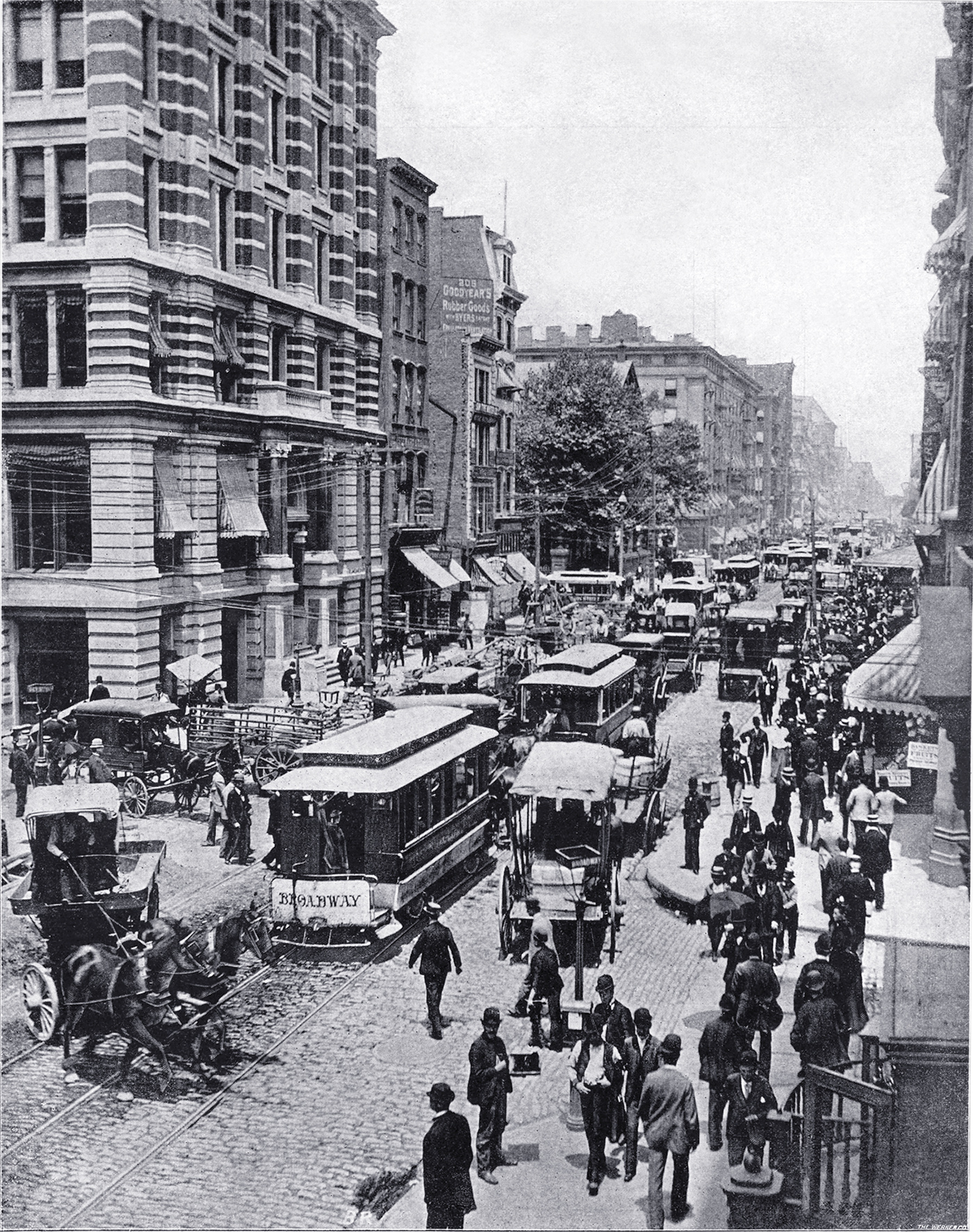
Traffic on Lower Broadway - about 1891
Broadway, looking north from the southeast corner of John Street. Photograph published in Portfolio colonial... des Possessions et Dépendances Françaises. Photographs collected by John L. Stoddard. Paris, Werner Company de Chicago, 1895. Author of the text: John Lawson Stoddard (1850-1931). Source: Gallica, Bibliothèque Nationale de France.
Note: by 1895 almost all overhead wires on Broadway were buried and utility poles were taken down. This process gained momentum in 1889, after the Great Blizzard of 1888. This photograph was probably taken about 1891.
The old 10-story Mail and Express Building (home of the New York Evening Mail) was completed in 1892 on the vacant lot seen here on the left, at 203 Broadway. We can see demolition works at the site.
The Western Union Telegraph Building, corner of Dey Street, is on the left. It was an early skyscraper completed in 1875. The old Astor House, completed in 1836, is seen at the northern side of Vesey Street.

Original text in French accompanying this photograph:
BROADWAY est la grande rue de New-York et la plus célèbre des voies anciennes de la grande cité américaine. Les magasins français y sont nombreux. C'est la rue du haut commerce. Elle part de Battrey-Place [Battery], qui est le point le plus méridional de la cité, et se dirige vers l'ouest. Broadway prend naturellement plusieurs formes dans sa traversée sinueuse à travers la ville. Au commencement elle passe par le Stock-Exchange, les anciens quartiers a la mode au moment de la guerre de l'lndépendance. Ensuite, on voit le célèbre café français Savarin; plus loin, un grand monument gris, la Poste. Au nord est un espace ouvert dans le centre de cette rue houleuse d'où l'on aperçoit les hôtels dcs journaux. Enfin, le square de l'Union sépare Broadway en deux. Du square de l'Union au square Madison, c'est une succession de petites boutiques jusqu'à ce que l'on retrouve, à la hauteur de la 23e rue, le grand commerce new-yorkais . Au nord de la 23e rue sont les grands hôtels et les théâtres. L'aspect de Broadway est unique au monde. Le boulevard Montmartre, à Paris, le Pont de Londres ne peuvent même donner une idée approximative de l'agglomération de piétons et de voitures qu'on y rencontre, et surtout de la hâte avec laquelle toute celle foule va, se presse. « Time is money! » disent les Américains, et ils savent appliquer ce précepte.
Translation to English:
BROADWAY is the main street of New York and the most famous of the old roads of the great American city. There are many French stores there. This is the high street of commerce. It starts from the Battery, which is the southernmost point of the city, and heads west. Broadway naturally takes many forms as it winds its way through the city. At the beginning it passes through the Stock-Exchange, the old fashionable districts at the time of the War of Independence. Next, we see the famous French café Savarin; further on, a large gray monument, the Post Office. To the north is an open space in the center of this rough street from which you can see the newspaper hotels. Finally, Union Square divides Broadway in two. From Union Square to Madison Square, there is a succession of small shops until we find, at 23rd Street, the big New York commerce. North of 23rd Street are the large hotels and theaters. The appearance of Broadway is unique in the world. The Boulevard Montmartre, in Paris, and the London Bridge cannot even give an approximate idea of the agglomeration of pedestrians and cars that one encounters there, and especially of the haste with which all this crowd moves and rushes. “Time is money!” » say the Americans, and they know how to apply this precept.

|
Copyright © Geographic Guide - Antique photographs of NYC. Historic Places. |
Traffic on Lower Broadway - about 1891